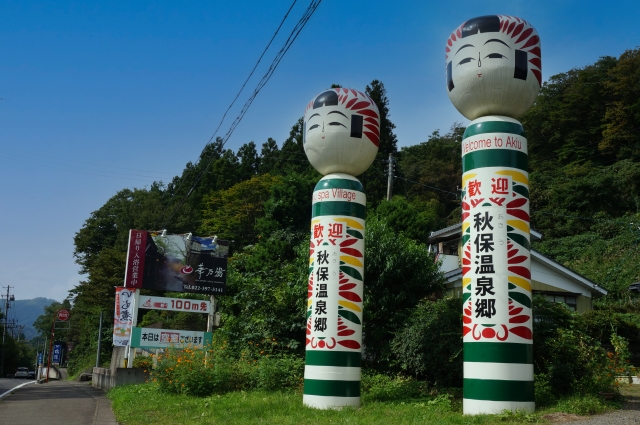Kokeshi dolls are surprisingly popular in Japan as a tourist attraction and abroad as a souvenir.
For decades, there has always been a kokeshi in every house. Since people buy them as souvenirs on trips or give them to others, the number of kokeshi dolls has gradually increased.
However, if you think about it, the meaning and origin of kokeshi dolls are not well understood, even by Japanese people.
So, let’s take a closer look at them on this page.

If you are looking for face-to-face or online Japanese lessons with the best Japanese tutors, please check here.
Contents
What is the histroy and meaning of Kokeshi dolls?
Kokeshi dolls were first made as souvenirs for hot spring resorts in the Tohoku region around the end of the Edo period (1603-1868).
At that time, 90% of the population were farmers, and hot-spring cures were an important event for people in the cold Tohoku region.
The custom of “cold-weather visits” in midwinter, “mud-removal hot-spring cures” after rice planting was completed, and “Doyou no Ushi no Hi” in summer gradually took root, and Kokeshi dolls were born.
In the beginning, kokeshi dolls were small enough to be held by children, in other words, they were toys.
They were used as kokeshi dolls for girls’ “oazuke” games.
The kokeshi as a toy reached its peak by the end of the Meiji period (1868-1912).
In the Taisho era (1912-1926), new materials such as celluloid and tin appeared in addition to the traditional wooden toys.
The focus of toys shifted from kokeshi dolls to these new materials.
Meanwhile, more and more adults began to collect kokeshi dolls for appreciation.
Eventually, kokeshi dolls were transformed from children’s toys into objects of appreciation for adults.
Kokeshi dolls are called by various names in different regions. Here are some of them.
- Kideko きでこ
- Dekoroko でころこ
- Dekunobo でくのぼう
- Kiboko きぼこ
- Houko ほうこ
- Kogehouko こげほうこ
- Kogesu こげす
- Kesiningyo けしにんぎょう
In addition, the following kanji characters were found to describe Kokeshi dolls.
- 小芥子
- 木芥子
- 木形子
- 木削子
- 木牌子
- 古け志
In response to these names and notations, the National Kokeshi Convention held in August 1939 at Naruko Hot Springs passed a resolution that the name “こけし” should be written in kana characters.
Perhaps due to the influence of this resolution, “こけし” and “コケシ” are now commonly used to describe kokeshi dolls.
There is also a theory that the origin of “こけし” is “子化身” or “子消し“.
This is generally considered a popular theory, as no supporting documents have been found.
A more popular theory is that they originated from “carved wooden karakuri dolls. Karashi dolls are bean carved wooden dolls that were popular during the Edo period (1603-1868).

Types of Kokeshi Dolls
Kokeshi dolls are classified into “traditional kokeshi” and “new type kokeshi.
Traditional kokeshi are kokeshi made in the traditional style. New-type kokeshi are kokeshi that have taken their own unique path based on traditional kokeshi.
Traditional kokeshi can be further classified into several lines according to the place of origin and other factors. Here are some of the most representative lines.
Tsugaru Type
Nuruyu Onsen and Owani Onsen in Aomori Prefecture are the main production centers.
The distinctive patterns of rokuro lines are the main features, and the body is decorated with nebuta patterns, flowers, etc.
Kijiyama Type
Kijiyama in Akita Prefecture is the main production area.
The forelock, fringe, and red ornaments are characteristic of this doll. The ume bowl pattern on the front of the body is famous, and chrysanthemum flowers and vertical stripes are also depicted.
Nanbu Type
Hanamaki Onsen and Morioka in Iwate Prefecture are the main production centers.
It is said to have developed from “kinako” (soybean flour), which was originally made as a pacifier.
Yajiro Type
The main production area is Yajiro in Miyagi Prefecture.
It is characterized by the multi-colored rings painted on its head.
Togatta Onsen Type
The main production area is Togatta Onsen in Miyagi Prefecture.
It is characterized by a red hair ornament called “tegara” on the head and a red radial pattern drawn from the forehead to the cheeks.
Naruko Type
This type is mainly produced in Naruko Onsen in Miyagi Prefecture.
It is characterized by the sound it makes when the head is turned. The body is often decorated with chrysanthemum flowers.
Sakunami Type
The main production areas are Sakunami Onsen and Sendai City in Miyagi Prefecture and Yamagata City in Yamagata Prefecture.
It is characterized by the red ring ornament on the head and the chrysanthemum pattern drawn between the upper and lower lines on the body.
Zao Takayu Type
This type is mainly produced in Zao Hot Springs in Yamagata Prefecture.
The Zao Takayu is characterized by the red radial decoration on the head and the okappa head.
Hijiori Type
The main production area of this type is Hijiori Onsen in Yamagata Prefecture.
It is characterized by the red radial decoration on the head and the flat head. The body is often decorated with a chrysanthemum pattern.
Tsuchiyu Onsen type
Tsuchiyu Onsen and Iizaka Onsen in Fukushima Prefecture are the main production areas.
The black snake’s eye ring on the head and the red “kase” hair ornament drawn between the bangs are distinctive features of this kokeshi.

Competition among Japan’s Three Greatest Kokeshi Dolls
In the Tohoku region, the birthplace of kokeshi dolls, competitions and festivals related to kokeshi dolls are held every year.
Here are the three major kokeshi festivals in Japan.
National Kokeshi Doll Festival
[Place] Osaki City, Miyagi Prefecture (Naruko Onsenkyo)
Dates 1st Friday, Saturday and Sunday in September
History Since 1948 (Showa 23)
A festival parade of “Big kokeshi dolls” is held.
All Japan Kokeshi Doll Contest
Place】Shiroishi city, Miyagi pref.
Date] May 3-5 [Date] May 3-5
History】Shiroishi-shi】 Held since 1959.
The Prime Minister’s Prize is awarded as the highest prize.
Michinoku Kokeshi Doll Festival
[Place】Yamagata City, Yamagata Prefecture
Date] Saturdays and Sundays after autumn
History] Held since 1981.
This festival features exhibitions and sales of traditional kokeshi dolls and wooden toys, as well as demonstrations by craftspeople.
Conclusion
Kokeshi dolls are wooden local dolls representing girls. They are characterized by a cylindrical body and round head, and usually have no arms or legs. Kokeshi dolls are a specialty of the Tohoku region, and were first made as souvenirs for spa visitors around the 17th to 18th centuries. Even today, kokeshi dolls are popular for their cute and simple appearance, and are sold as tourist souvenirs outside of the Tohoku region.
The raw wood used for kokeshi dolls is mainly mizuki (dogwood) and sakura (cherry). The logs are placed on a potter’s wheel and whittled while the wheel is turning. After shaping the log, the hair and eyes on the head and the kimono on the body are painted with a brush. This technique is a craftsmanship passed down from master to apprentice.
- Kokeshi dolls were first made as children’s toys in the late Edo period.
- Kokeshi had various names and descriptions, but they are believed to have converged on “kokeshi” after the resolution of the National Kokeshi Convention in 1939.
- As for the origin of the word “kokeshi,” the prevailing theory is that it comes from “an outrageous doll made of wood.
- Traditional kokeshi can be classified into about 10 different lines, depending on their place of origin and other factors.
Related article:










